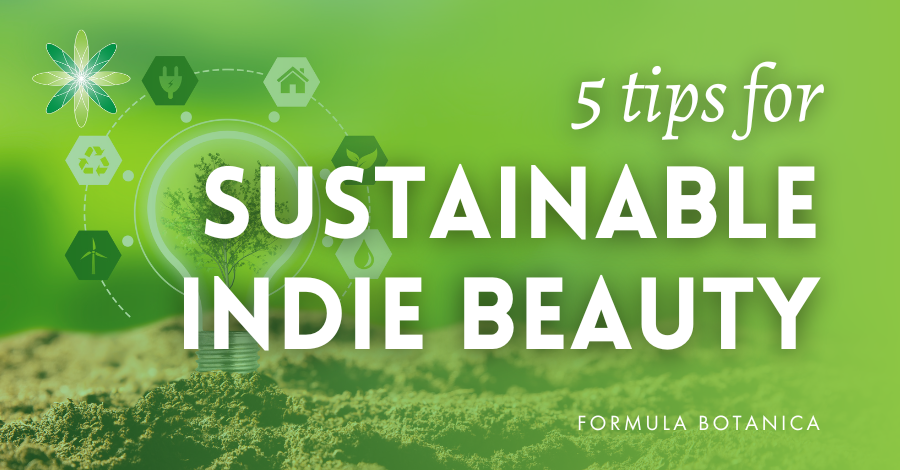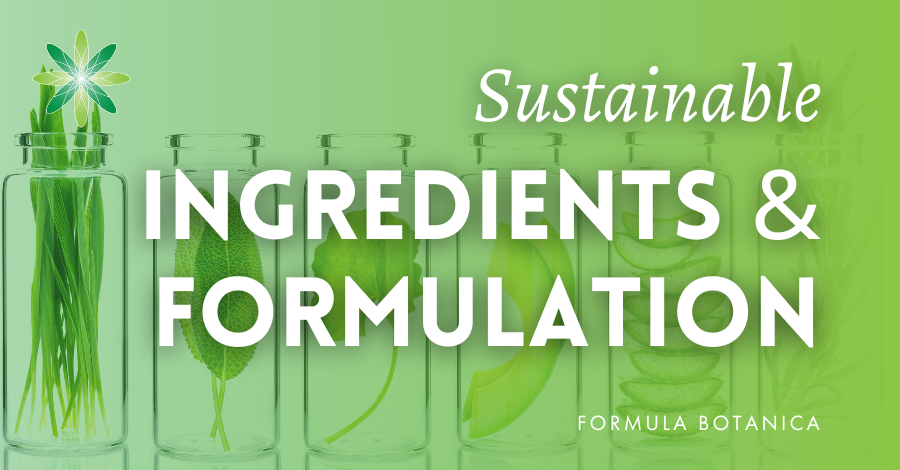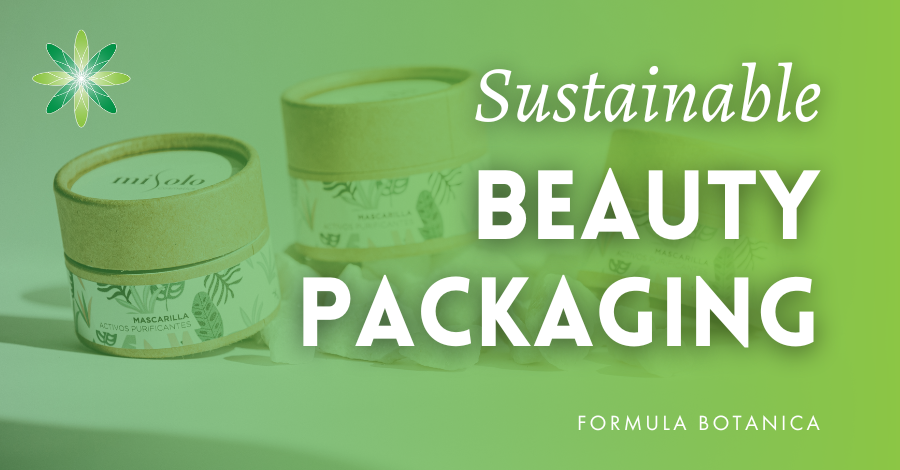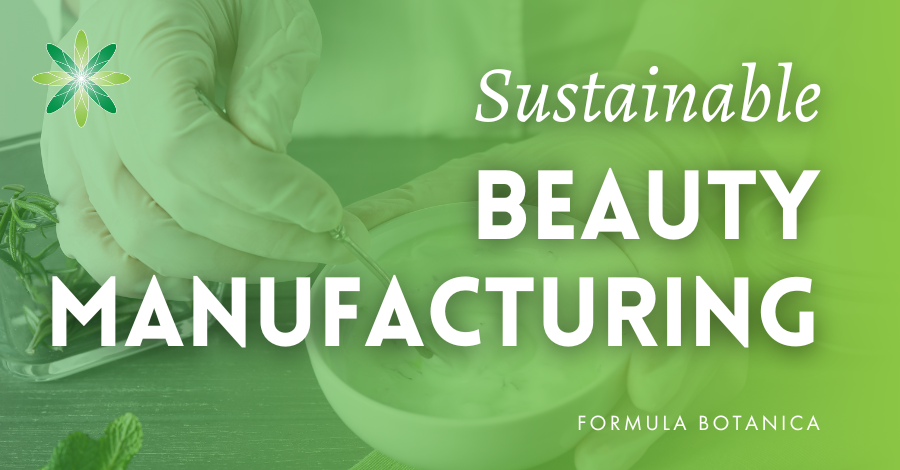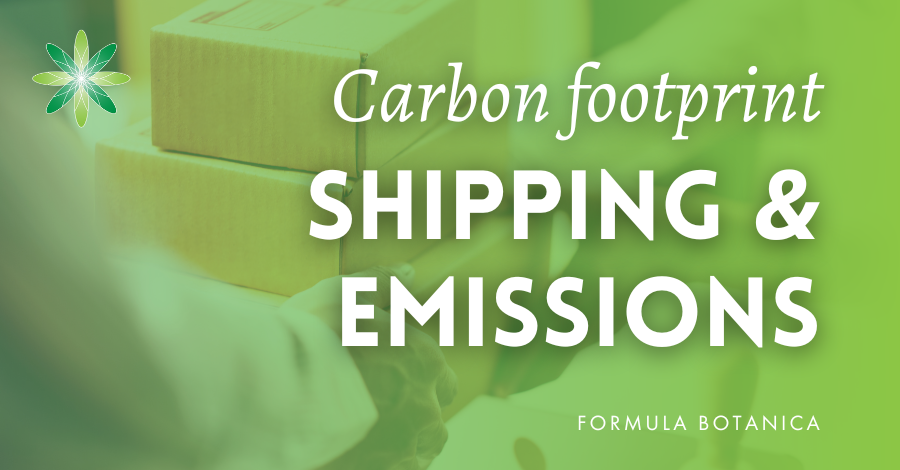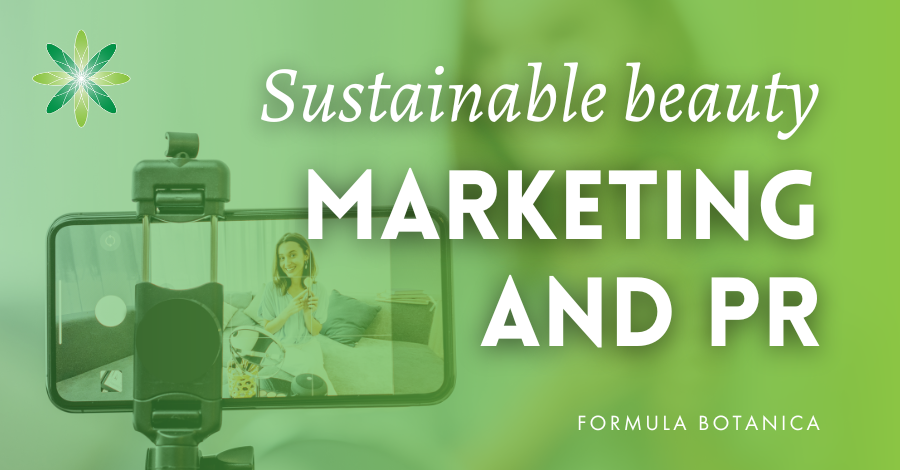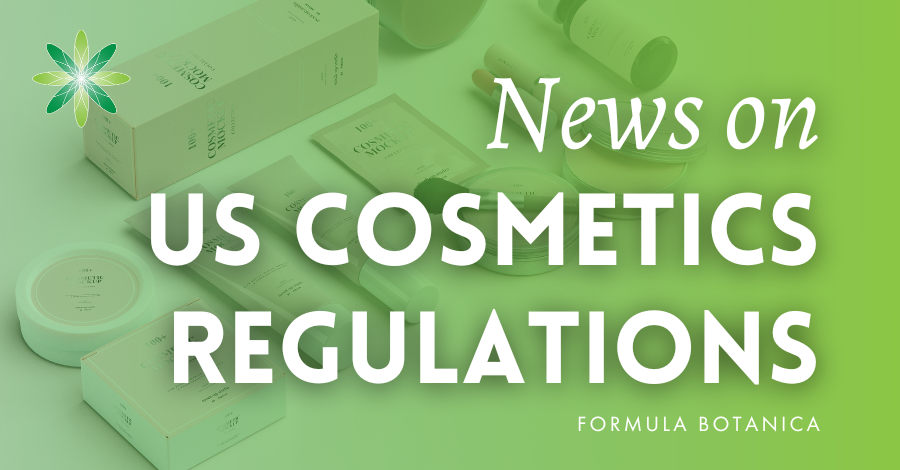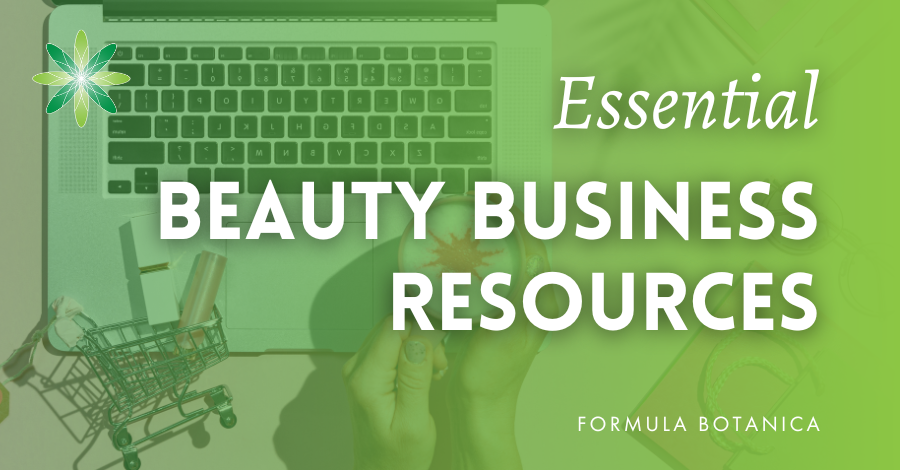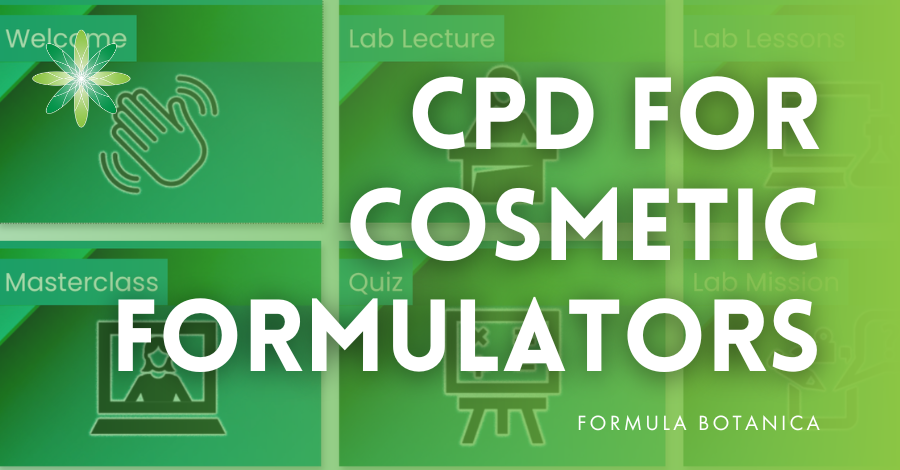Launching an indie beauty business is exciting, but it’s important to remember the impact that your business could have on the environment. As a natural, organic cosmetic formulator, you will want to make sure that your brand is as sustainable and eco-friendly as possible.
Yet sustainable beauty is a complex subject plagued by greenwashing. The Formula Botanica Green Beauty Conversations podcast has explored numerous aspects of sustainable beauty, delving into the facts behind various claims and exploring accreditation schemes.
As an indie beauty entrepreneur, you will be keen to do the right thing for the planet. Having seen hundreds of our graduates’ brands launch and having interviewed tens of beauty pioneers on the podcast, at Formula Botanica we can certainly say it is better to build your business foundations on sustainability practises at the outset rather than retro-fit them later, which can be more costly.
In this blog post, we provide a practical guide and resources for indie beauty entrepreneurs who want to create a more sustainable, environmentally- and climate-friendly beauty business. Not all our points may be possible to act on, but by thinking them through, you can plan and adopt the measures you can at sensible junctures in your business as it develops.
Remember, sustainability is a journey for everyone in the industry, but smaller, nimble, founder-led indie beauty businesses do have the flexibility to adopt sustainable beauty practices, often more effectively and faster than established mainstream beauty businesses. That’s an encouraging start.
5 practices to run a more sustainable beauty business
1: Cosmetic ingredients and formulations
The very ingredients you choose, how you source them and how you formulate with them are fundamental to your drive for greater sustainability in your beauty business. This is an aspect over which you have the most control as an indie beauty business owner and cosmetic formulator. You decide on your formulating ethos right at the start. While packaging choices may be more limited, given the minimum order quantities you may need to purchase, ingredients offer more flexibility in choice and offer you the chance to formulate more sustainably.
Choosing sustainable and environmentally friendly ingredients
First and foremost, it’s important to prioritise sustainable and environmentally friendly ingredients. This means looking for ingredients that are ethically grown, harvested, manufactured and distributed with a minimal impact on the planet. For example, you might choose ingredients that are certified organic, fair trade, or sustainably harvested. The only way to find out these things is to research your suppliers and ask them questions.
If you wish to ensure, for example, that your shea butter is produced ethically by women cooperatives in Ghana who are paid a fair wage and work in good conditions, you need to do your homework. However, suppliers that care about these issues are likely to communicate this on their websites. We interviewed Sheabutter Cottage, an ingredient supplier, about transparency on our podcast:
See also our blog post all about how to source sustainable ingredients:
Using local and organic ingredients
Using local and organic ingredients is another important step towards sustainability. This can not only help reduce carbon emissions associated with transportation, but it also supports local businesses and allows you greater oversight of the ingredients used in your products. You may be able to visit local suppliers to see how the ingredients are produced.
Our podcast episode 197 with Copenhagen-based Formula Botanica graduate Stella Nisreen Kanaan is inspiration for going the extra mile in sourcing local botanicals. Stella is expanding her beauty business by working with local farmers to grow specific herbs important to her formulations and brand mission.
However, locally grown, natural and organic botanicals are not automatically more sustainable, as Formula Botanica CEO and podcast host Lorraine Dallmeier points out in her green beauty opinion Episode 108: Let’s celebrate and conserve botanicals. As indie beauty brands, we need to ensure our use of precious botanicals does not deplete or harm them. We must exploit plant power sustainably, ensuring the bounty of botanicals thrives, not just survives, for future generations. For more on this, listen to:
Episode 106: Should indie beauty go local?
Use essential oils wisely
Natural cosmetic formulations often include essential oils to impart fragrance and offer skincare and haircare benefits. We explored the common herb rosemary, looking at its amazing, multifunctional role in our cosmetics that ranges from its scent to its power as an antioxidant.
But be aware that the beauty, lifestyle and wellness industries, among others, are using essential oils liberally, thereby placing pressure on land and the environment. To get a perspective on essential oils, listen to Episode 75 “How sustainable are essential oils?” with Dr Sally Gouldstone, a career conservationist and beauty founder. We hear how some essential oil crops may yield at the most just 2 percent oil with 98 percent of the plant matter wasted. Single essential oil cash crops can also harm biodiversity.
Creating sustainable formulations
Less is usually more when it comes to sustainable beauty businesses. The fewer ingredients and manufacturing processes required to create a formulation, the more resources are saved. Try to formulate with carefully selected ingredients (as we outlined above) and ones that require less processing, especially heating, in order to be incorporated into formulations. There are, for example, excellent cold-process ingredients on the market, including new types of emulsifiers that do not require heating. Many cosmetic ingredient manufacturers are exploring so-called “green chemistry” options in developing new products. Even as a small, indie formulator and business, you can access portals that filter suppliers and ingredient types by various criteria, including sustainable practises, energy use, cold processing, and more. See our podcast interviews:
Episode 79: The challenge of sourcing natural ingredients with supplier portal Covalo, which provides a one-stop shop for formulation-driven product development, including the sourcing of sustainable ingredients.
Episode 115: taking cosmetics’ transparency to the next level in which we interview Novi Connect, a platform helping demystify the cosmetic ingredient supply chain for formulators and brands keen to make their product development cycles more transparent and sustainable.
2. Choosing eco-friendly packaging materials
Packaging materials are naturally one of the first things any indie beauty entrepreneur thinks about when trying to run a sustainable beauty business. Packaging is also the first thing the consumer experiences when assessing beauty products in a store or unboxing beauty products bought online. It can be tricky to balance the packaging you desire in order to give your consumers the best experience of your brand with your wish to use less packaging and more sustainable materials.
Packaging is a huge, global industry, and we often quote on this blog the staggering statistics about the volumes of plastic packaging the beauty industry uses. The personal care industry alone creates 100bn units of plastic packaging a year, and half of all plastics ever manufactured have been made in the last 15 years. Most indie beauty entrepreneurs would wish to play their part in reducing, recycling and removing packaging waste, especially plastic packaging, as much as possible. But they often face limited choices and higher costs as many truly innovative packaging options require you to purchase large minimum order quantities. Some, like the Magical Mushroom Company interviewed on our podcast, work to resolve these issues as they see their clients as long-term partners.
As packaging is a complex topic, we urge you to head over to our other resources to deep dive into the implications of using and choosing various packaging types and to get some ideas about how to innovate as a small indie brand in your packaging choices. Start with:
The indie beauty guide to green packaging; and
Episode 117: Should beauty go plastic free?
The podcasts below provide inspiration in the form of case studies of leading beauty founders on how they rethought their packaging and the customer experience of their brands:
Episode 143: The brand creating mascara tubes to last 2,500 years – an interview with Izzy Zero Waste.
Episode 125: Return, refill, repeat with Beauty Kitchen – founder and sustainability pioneer Jo Chidley on a ground-breaking returns’ scheme.
Episode 109: A beauty refill business where bigger is better – hear how Meow Meow Tweet encourages bulk buys and the return of empty containers.
3: Manufacturing and Production
One of the key areas to focus on in any sustainability drive is reducing energy consumption. If you run your own manufacturing operations, you have greater control over this. Sarah Brown, entrepreneur and founder of award-winning global brand Pai, told our podcast that she kept all manufacturing in-house but added that building and maintaining your own facilities was not for the fainthearted.
It is a massive undertaking and investment and probably a route open to large brands, although we discovered in our interview with May Lindstrom that she runs her own manufacturing on a more manageable scale. With your own facilities, you have the chance to develop truly energy-efficient operations.
However, even in a home lab or start-up facility, you can make energy savings. This can involve simple measures such as turning off lights and equipment when not in use and using energy-efficient bulbs and appliances, as well as opting for the simpler and/or cold-processed formulations that we mentioned earlier.
In addition, try to source from suppliers that also prioritise energy efficiency. Some forward-thinking manufacturers are adopting renewable energy sources and reducing waste, but it can be difficult to assess their commitments. Many corporate mission statements mention sustainability, but there is little transparency in the industry about how sustainability initiatives are implemented and how their effects are measured. You can find out more about these issues by listening to our interview with the sustainability pillar president at the British Beauty Council in:
Episode 77: Does the beauty industry have the courage to change? – the Council produced a 48-page report on the state of sustainability in the industry.
Waterless beauty – misconceptions and myths
Water is another resource in short supply the world over. Implementing water conservation measures is also essential for creating a more sustainable beauty business.
Waterless beauty products are touted as helping reduce water usage and are a trending category in beauty. It is important to sort the myth from the facts here. While a product may be formulated without water in its ingredients, it is highly unlikely that it does not have a water footprint. An anhydrous balm, for instance, may contain oils and butters that have seen water used in their growing, processing and transportation.
On the plus side, waterless products are usually solid, and this may reduce their packaging, which in turn reduces the water and energy consumed in packaging production, shipping, and so on. Solid products can be lighter, and this can have an impact on reducing their carbon footprint in transportation. The beauty industry will remain a heavy user of water, but, as you can see, there are ways to make waterless work towards your sustainability goals. We cover waterless beauty in these articles and podcasts:
Episode 83: How waterless beauty greenwashed the beauty world.
The myth of waterless beauty.
4. Shipping and carbon emissions
As we mentioned above, sourcing locally does have the advantage of reducing the carbon footprint from excessive transportation and shipping of raw ingredients, packaging, and more. The reality is, though, that fossil fuels remain a huge part of our personal daily lives and, inevitably, our beauty brand operations. This is the area that most takes the form of a journey, but we have seen some brands achieve milestones in reducing their emissions and carbon footprints.
However, even the graduate brand founders of BYBI, whom we interviewed about their achievement of attaining carbon-negative status, acknowledged that carbon emissions from shipping their products remained a final barrier. Listen in to a fascinating, deep and wide-ranging interview on just how one indie brand achieved its sustainability mission:
Episode 87: Selling skincare while sinking carbon – is this possible? – our interview with BYBI, and see also:
Episode 50: Can a beauty brand ever be carbon neutral?
Episode 71: How to make the beauty industry climate neutral.
5: Marketing. branding and PR
How you communicate your drive to be a more sustainable beauty business and how you educate your customers about your mission are integral to your success on your journey to greater sustainability. As you can see from the many podcasts we linked to above, greewashing is rife in the beauty industry.
There are so many claims and accreditation schemes, as well as misinformation out there, that it can be difficult for both brands and consumers to make sense of sustainability. Beauty brands may latch on to one aspect of their operations as an example of sustainability in action but be silent on other aspects of their business. We are left wondering how to measure the effects of what they say anyway.
The important point is to never make a claim you can’t substantiate and to ideally use a trusted third-party such as Provenance, a company using Blockchain technology to verify claims beauty brands, and others, make about a range of issues, including sustainability. The interesting thing about the Provenance model is that it acknowledges the journey and allows brands to be verified for small, stepping-stone claims, even on a product level, rather than requiring a company as a whole to be, for example, climate neutral. We said at the start that sustainability is an ongoing journey, not a destination.
Take your customers on that journey, explaining the steps you make and the small wins you achieve towards greater sustainability in your beauty business. Treat them with respect and be transparent and honest.
Also, be aware that every aspect of your business needs to align with your declared sustainability goals. It is no good saying you outsource manufacturing to a state-of-the-art, solar-powered manufacturing plant only to deliver your products in excessive packaging that the user will rip off and may not be able to recycle anyway.
Your brand story and mission need to be thought through carefully and intentionally, not developed on the fly in response to the latest sustainability trend. Above all, be yourself – the indie founder responsibly doing what you can to be a more sustainable beauty business.
Sustainable practices for indie beauty – conclusion
Creating a sustainable and eco-friendly beauty business requires effort and dedication, but it’s worth it for the health of the planet and the future of your business. By implementing sustainable practises throughout your business, you can reduce your environmental impact, save money, and attract customers who value sustainability.
In the future, sustainable beauty will have to be the norm, not the exception, in the industry, so it is right to start thinking about it now. The eco-beauty pioneers of today will be those who eclipse their peers tomorrow. By taking small steps now and seeing sustainability as a journey, you can achieve some wins today. This will help you avoid overwhelm and also give you the confidence to continue your drive towards greater sustainability throughout your beauty business. We hope this guide has provided you with food for thought as well as practical tips and resources to help you launch and grow a more sustainable beauty business.
FREE TRAINING
Learn how to become an
Organic Skincare Formulator
FREE TRAINING
How to become an
Organic Skincare Entrepreneur
FREE TRAINING
How to become an
Organic Skincare Entrepreneur
Leave us a comment

Liz was Formula Botanica’s Content Coordinator between August 2020-2024. Liz worked as a professional blogger, journalist and site developer for many years and was also part of the Formula Botanica student community. Read more about the Formula Botanica Team.

